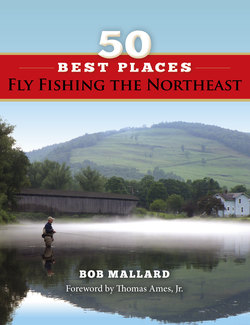Читать книгу 50 Best Places Fly Fishing the Northeast - Bob Mallard - Страница 16
На сайте Литреса книга снята с продажи.
Оглавлениеmany do not due to low dams, shallow impoundments, or mid-depth releases from high dams.
Most Northeast rivers are what would more accurately be referred to as freestone—even many that originate at a dam. On freestone rivers, the bottom is usually strewn with rocks and boulders of various sizes. Slower sections are often covered with sand and gravel—and even mud or silt. They tend to warm up as the season progresses. Flows are inconsistent and often unpredictable. This is the classic Northeast river.
The Northeast’s streams and brooks are mostly freestone. There are, however, meadow streams, estuary brooks, and the aforementioned limestone creeks. Most freestone streams are relatively infertile and subject to radical flow changes. Many of these suffer from low water in the summer. Some get too warm to hold trout throughout the year. But many do hold trout—even wild trout.
Limestone creeks are to the Northeast what spring creeks are to the West. They get their water from underground springs. Limestone creeks are found primarily, but not exclusively, in Pennsylvania. They have consistent water temperatures and flows, and robust plant and insect life. They are as tough to fish as any waters in the country—and some would argue the toughest. If you can catch fish on a limestone creek, you can catch fish anywhere.
While not as popular with fly fishers as moving water, lakes, ponds, and reservoirs offer some unique, challenging, and fun opportunities for those willing to try them. Like the differences among rivers, streams, brooks, and creeks, the difference between lakes and ponds is murky at best. There are ponds that are larger than some lakes—so it is not a size issue.
Saltwater fly fishing in the Northeast is done offshore, in the surf, in estuaries, and on the flats. Like our tailwaters, our Northeast flats do not fit the classic definition. Thinking of saltwater flats conjures up images of white sand, turquoise water, and boats with poling platforms. While some flats in the Northeast fit that description to some degree, many do not. But they are beautiful nonetheless.
The Fish
The Northeast is home to myriad gamefish species. These include ten salmonids; largemouth and smallmouth bass; pickerel, pike, and muskellunge; carp; and stripers, bluefish, and false albacore in salt water. Fly fishers target them all, and they represent a level of diversity found in few if any other places in the country.
Five of the ten salmonids are native to the Northeast: brook trout, lake trout, landlocked (Atlantic) salmon, Atlantic salmon, and Arctic char. The last two are some of the rarest
salmonids in the country. Steelhead, along with king and coho salmon were introduced to the Great Lakes to create a sport fishery. Coho were also introduced to some coastal rivers in New Hampshire and Massachusetts, but never took hold. Rainbow and brown trout were introduced throughout the region, as they were elsewhere in the country.
While smallmouth and largemouth bass are native to the Northeast, the range of both species has expanded greatly over the years. But when it comes to fly fishing for bass in the Northeast, the smallmouth is king. The same can be said for pike and muskellunge in regard to range expansion. While neither has been pursued by fly fishers in the Northeast to the same extent as trout, salmon, and bass, they are caught on fly tackle.
The Fishing
When it comes to trout fishing, Connecticut, Massachusetts, New Jersey, and Rhode Island have done a lot with a little. While they do not have the number of quality fly fisheries the other states have, each can lay claim to some of the finest trout fishing in the Northeast. The first has some pike fishing, all have some smallmouth fishing, and all offer saltwater fishing for striped bass as well.
New Hampshire and Vermont are arguably the two most beautiful states in the Northeast. Both have diverse fly-fishing offerings. From trout to salmon to pike; from large rivers to small mountain streams, from large lakes to tiny ponds, these states offer something for everyone.
Maine boasts seven species of salmonids: brook trout, brown trout, rainbow trout, lake trout, landlocked salmon, Atlantic salmon, and Arctic char. It is the only state where the last two still exist, and has more wild and native salmonid water than any state in the Northeast. It is also a top smallmouth bass and striper destination.
New York has some of the most famous trout, salmon, and steelhead rivers in the Northeast. Plus it offers some of the finest smallmouth and striped bass fishing in the Northeast. When it comes to fly fishing, New York truly has it all.
Pennsylvania’s Heritage Waters are some of the finest wild trout fisheries in the country. The state is home to the largest concentration of spring creeks—locally referred to as limestone creeks—east of the Mississippi. There are steelhead and smallmouth bass as well.
Access
Landowner rights and trespass are complicated issues. Some Northeast states have seen court battles related to trespass driven solely by angler access. Laws governing access have
